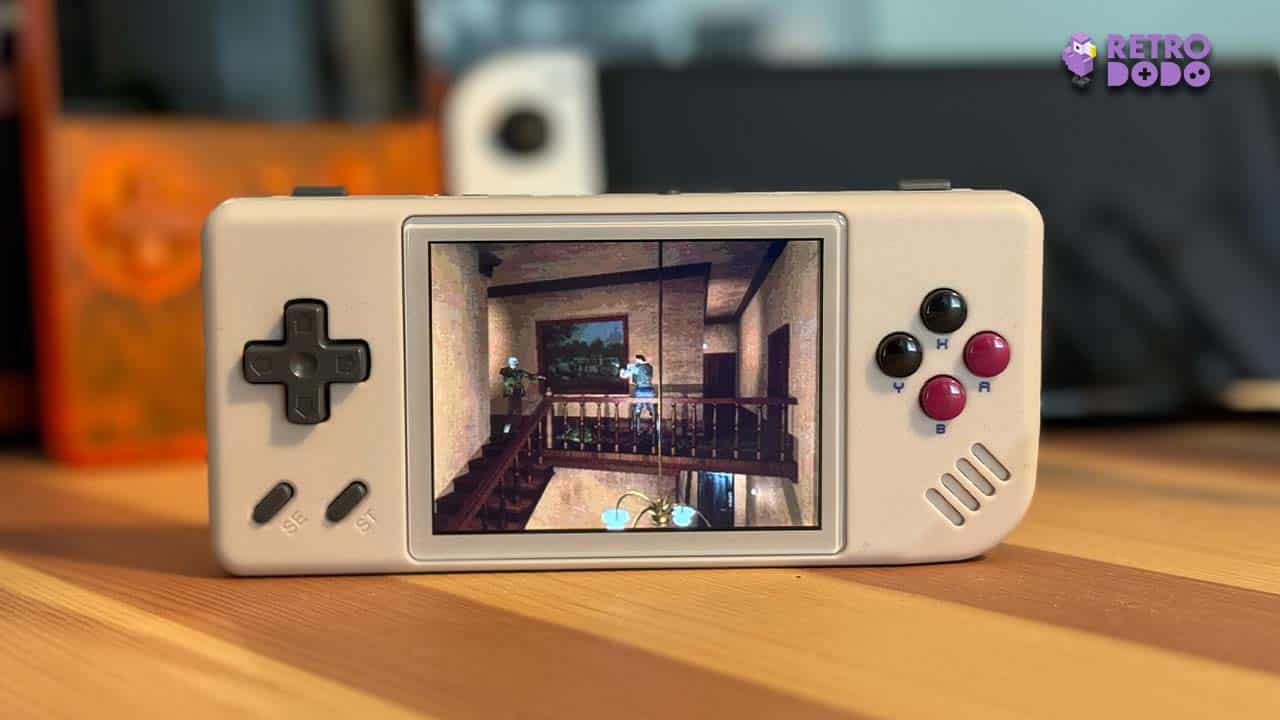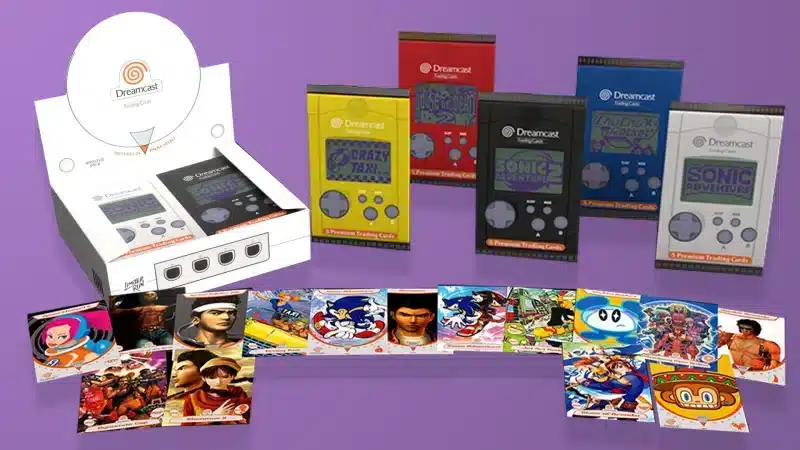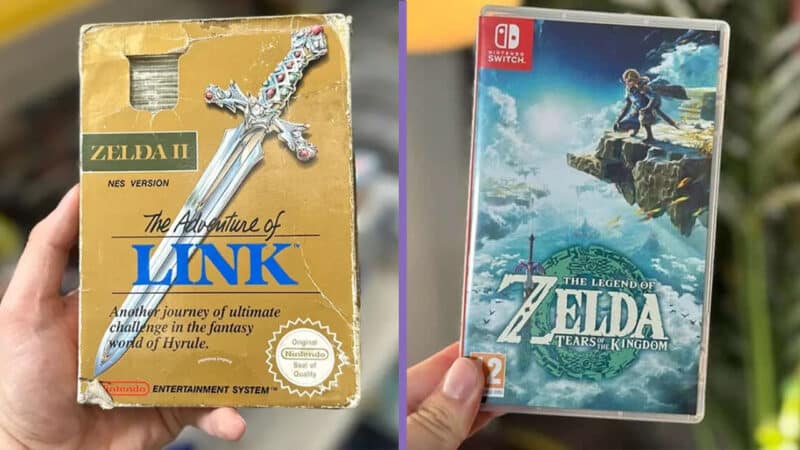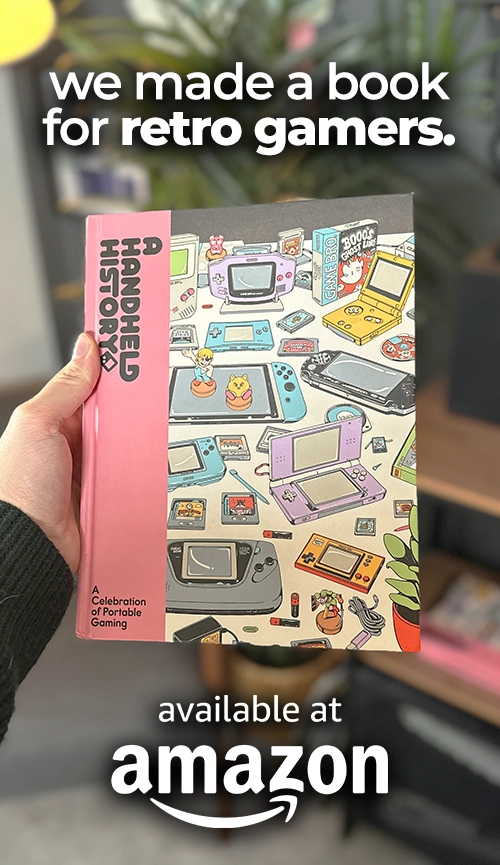We’ve been no strangers to Anbernic’s products over the years, covering their handhelds in great detail whenever they release a new handheld (which seems to be more frequently than I have hot dinners). They often surprise us, however, bringing out solid machines that, while not always feeling as premium as products like the anodized steel Analogue Pockets, still manage to take us back to the moments when we first played many of our favourite games for the very first time.
But how does the RG28XX hold up to other horizontal handhelds on the scene regarding build quality, user experience, and game compatibility? Does it emulate consoles as well as the original hardware? Do games run smoothly, and do the buttons feel like they’ll withstand a serious session on Crazy Taxi?
I’ve been putting this handheld through its paces for the past week to get a really good feel for how everything works in a bid to answer all of those questions and more. With games from the PS1 through to vertical shooters, I’ve thrown everything at the Anbernic RG28XX in this review to see if it can live up to the hype and, more importantly, my high expectations from horizontal handhelds
Table of Contents
First Impressions Of The Anbernic RG28XX
- Release Date: April 2024
- Current Price: $39.99
- OS: Linux
- Where To Buy: Anbernic or Amazon
- Competitors: Powkiddy RGB10S, Miyoo Mini
When I first got the RG28XX out of the box, my initial thought was ‘This thing is small’. It instantly reminds me of a Game Boy Micro, and the screen sizes aren’t much different with the Micro screen measuring 2″ and the RG28XX coming in at 2.83″. In relation to my iPhone 15 Pro, it’s about 3/4 of the size, so that should give you a rough idea of the size before I get to the official measurements in the next segment.
I’m instantly taken back to the first time I picked up my Game Boy DMG too. See, here I am in the second paragraph of this section and I’ve already mentioned the Game Boy twice, but that’s not a bad thing in my eyes. Anbernic has instantly captured my love of my favourite handheld with every aspect of this model; the original DMG grill design and curved corner, the placement of the select and start buttons, the colour scheme of the A, B, X, Y buttons, and the colour of the casing. It’s been perfectly recreated to evoke nostalgia, and it’s certainly achieved its mission.
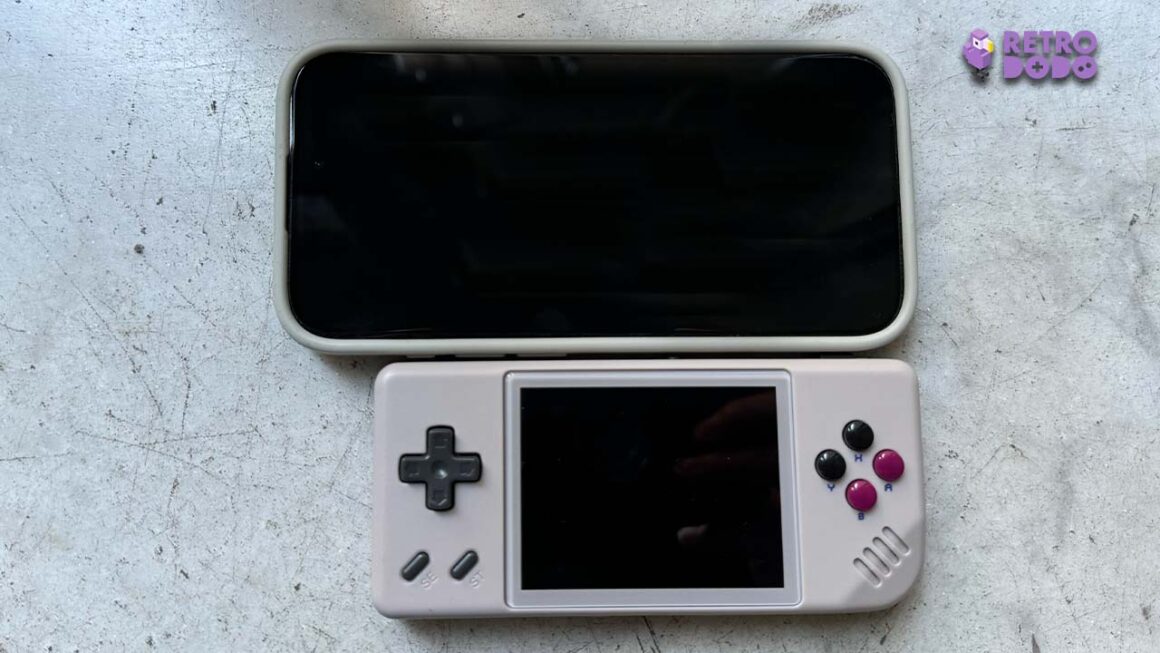
You know how when you shake some cheap handhelds all of the buttons rattle? The RG28XX only has a little bit of rattle coming from the L2 and R2 buttons, and the rest of the buttons feel very secure. Ok, they don’t feel like they’re made from premium rubber as some select and start buttons might, but the plastic doesn’t feel like it will crumble underneath your fingers on the first play which is reassuring.
My initial thoughts before turning this thing on, however, were already ‘This isn’t going to be anyone’s main handheld’. I’ve got a feeling that it’s going to be perfect for travelling, which is why I brought it on holiday to Austria with me, but I’m guessing the size is going to be problematic as I continue testing.
ANBERNIC RG28XX Specifications
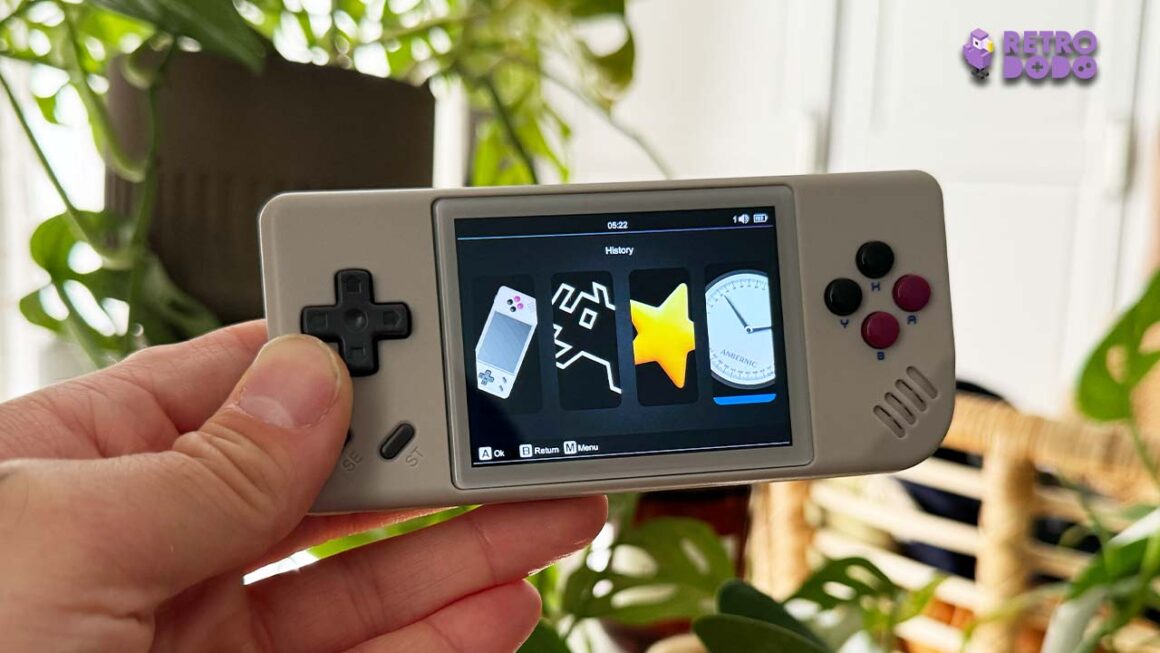
- Linux Operating System
- 4 Cores
- 125mm wide x 57mm high x 15mm deep
- Weight 0.125kg
- 640×480 resolution
- 2.83″ Screen Size ~ 4:3 aspect ratio ~ 228ppi
- 1GB RAM
- 3100 mAh Li-Po battery
It’s no surprise that the console uses Linux as its operating software, and it makes for a great user experience. Game Room & RA Game (RetroArch Game) provide access to all of your consoles, though weirdly there are some consoles on one of these options that don’t show up on the other. It’s a small price to pay, but it pays to acquaint yourself with which consoles are on which setting.
Favourites and History are great for diving straight back into titles you have been playing previously without having to mess around searching through reams and reams of games, and a quick press of the M button on the top of the console brings up key settings like Lock Screen, brightness, icon settings, and much more. Overall, I can’t complain about the OS at all, a perfect fit.
Battery life is pretty impressive too, I’ve put in some serious gaming stints and even left it on sleep for a full day and had plenty of battery left at the end of the day to get in a few rounds of CTR before bed. Anbernic states that the battery will give you 8 hours of continuous play, and from what I’ve experienced so far, I would say its closer to 6 hours depending on what consoles you are emulating.
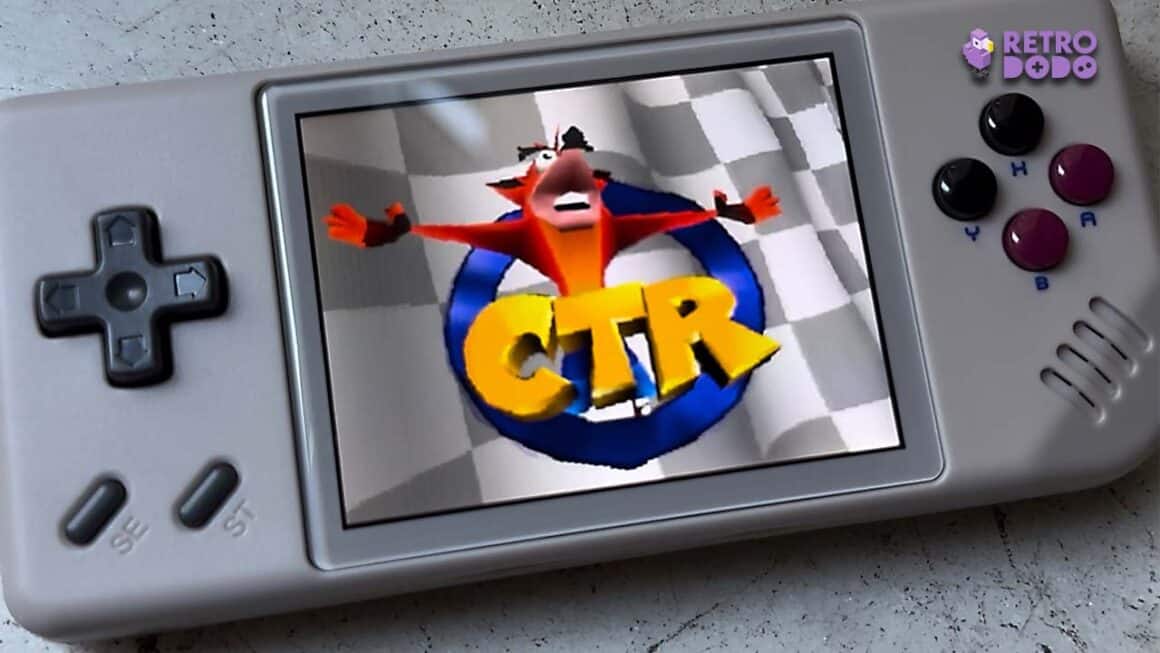
Let’s talk screen size – playing games like Crash Team Racing on a small screen isn’t ideal. The 4:3 ratio is nice as it doesn’t stretch games that were never meant to be played on a widescreen format and there’s no need for any black lines down the side of the screen like we get on the Nintendo Switch while playing older games.
Still, 2.83″ isn’t massive, and you do find yourself holding the handheld quite close while playing. I’m not talking the same distance from your eyes as your granny trying to read the newspaper, but still – it’s quite small when it comes to detailed games.
Game Compatability
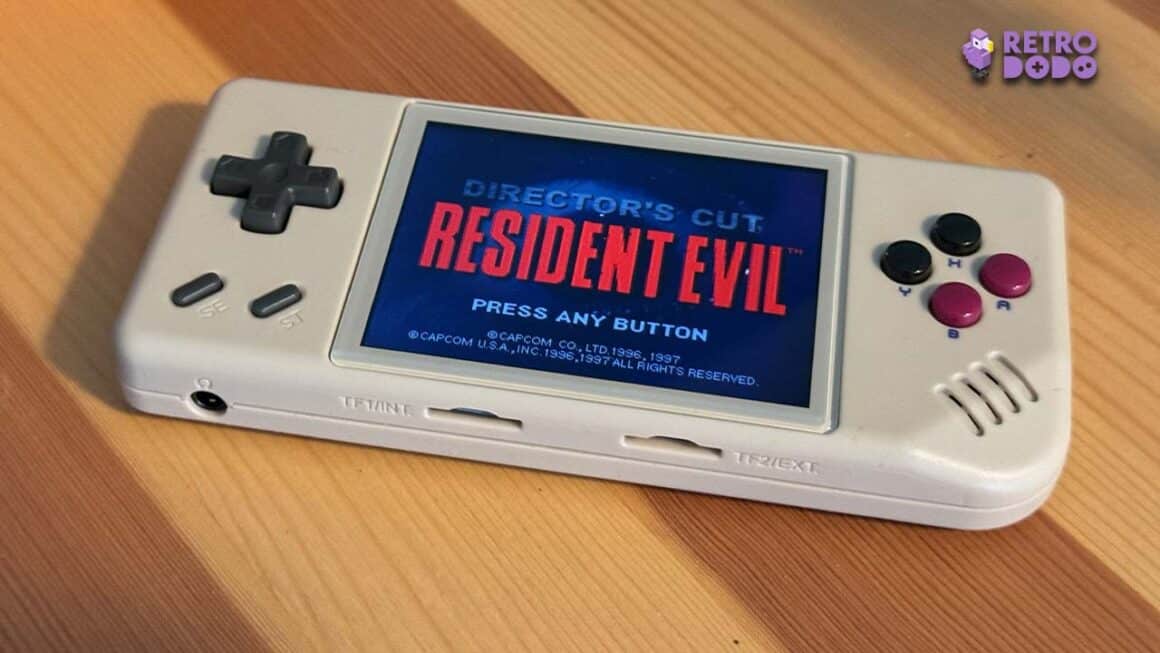
I’ve mentioned games so much now that I really should start talking about which consoles this thing emulates.
- PS1
- Vertical Arcade
- CPS1, CPS2, & CPS3
- NEOGEO
- FBneo
- MAME
- GBA
- NES
- SNES
- Sega Master System
- Mega Drive
- Mega Drive CD
- Sega 32X
- GBC
- Original DMG
- PCE
- PCE-CD
- NEO GEO Pocket Color
- Game Gear
- WonderSwan
- WonderSwan Color
- Dreamcast
- PSP
- OpenBOR
- Pico
- Homebrew
- Virtual Arcade
- Poke Mini
- Atari 2600
- Virtual Boy
- Game & Watch
- Famicom
- MSX
- Atomiswave
- Sega Naomi
I know; that’s a big list for such a small handheld. As I said above, there are consoles like the PSP and Virtual Boy which appear in RA Game and not in Game Room, so you need to search both to find all of the consoles.
Now, this is a little controversial and something that I’m not sure a company that rhymes with ‘Winchendo’ will like, but the RG28XX comes preloaded with more games than I think I could ever complete if I lived to be 120 years old. All of the consoles listed above have games ready and waiting to play, and I’ve not come across one that doesn’t load smoothly and play like a dream yet.
Let’s talk about some of the consoles that you’ve seen in that list that I know you’ll be chomping at the bit to find out about – Dreamcast, PS1, and PSP.
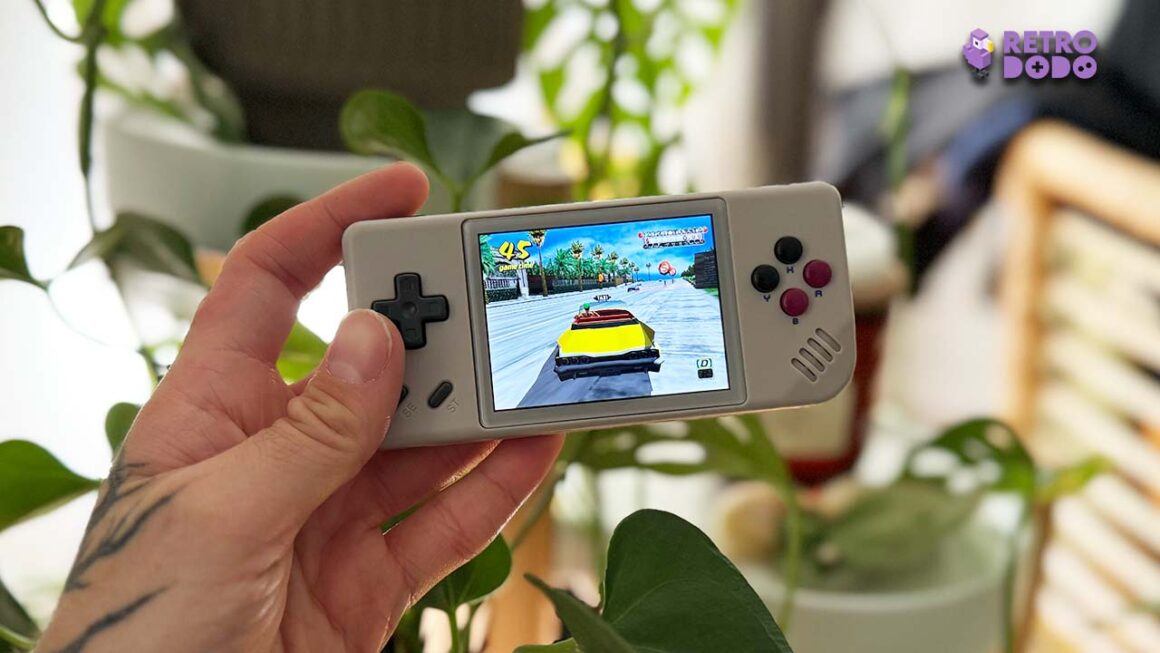
I’ve been playing Crazy Taxi this morning while procrastinating about doing this article and it was a joy to play. Obviously, the controls vary from console to console and aren’t universal, so if you’ve never used a Dreamcast before you’ll need to wrap your head around the fact that the B button on the RG28XX is now the A button and so-on-so-forth.
There’s even a solid rumble when you hit other cars too; you can turn the vibration function off on the settings, but I was pleasantly surprised at how strong it was for such a small console.
PS1 played perfectly too – Crash Team Racing, Final Fantasy VII, and Resident Evil all played smoothly. When it comes to PSP, the story was a little different. Side-scrolling games like Castlevania: The Dracula X Chronicles played well, as did less taxing titles like Pac-Man, but games that demand a lot more like Parasite Eve: The 3rd Birthday were unplayable on the RG28XX as it lacks an analogue stick to allow players to move. I rolled a little bit and then gave up. God of War, the most demanding title on the console, was absent from the included ROMs too. So when it comes to PSP, the cutscenes run smoothly, but the gameplay is hit-and-miss. If you have an external controller to hook up for games like Parasite Eve then you can overcome the lack of an analogue stick, but that defeats the point of having PSP games on a handheld console in my opinion.
As we know from previous experience, it takes something with the power of a Steam Deck to power more demanding consoles like the 3DS, so I never turned this handheld on expecting to see titles like Animal Crossing or A Link Between Worlds on there.
We’ve been putting the Anbernic RG28XX through its paces for an official review – a budget-friendly handheld, but how does it play?
— Retro Dodo (@retro_dodo) August 7, 2024
Review coming soon over on the website!#retrogaming pic.twitter.com/6M5uXYMADl
Sound Quality
I’ve said a lot of positive things about this handheld so far, so it’s time to even out the odds a little bit. Obviously, for a handheld that measures 15mm deep, it isn’t going to have the space to put a humongous subwoofer in the casing, nor is it going to feature Bose speakers and still stay in a budget pricing frame for users to pick up. Still, the sound is a little tinny, it has to be said. It’s not something that I would play on loud for long periods of time as I think my ears might end up bleeding.
It’s a different story with headphones, however. I plugged in my Urbanista over-ear headphones into the headphone jack at the bottom of the handheld and suddenly was greeted with the rich, vibrant tones of Crazy Taxi that I remember from the days of the Dreamcast. If you have a decent set of earphones (wired as it doesn’t have Bluetooth), then I would wholly recommend that as the best way to play.
One thing I will also include is that the speaker makes a little ‘crackling’ noise whenever you close an application. It’s not a massive problem and is just normal sounds from the console’s internal gubbins operating, but it’s worth noting if you’re new to handhelds and are wondering whether you’re handheld is about to break.
How Does It Feel To Play?
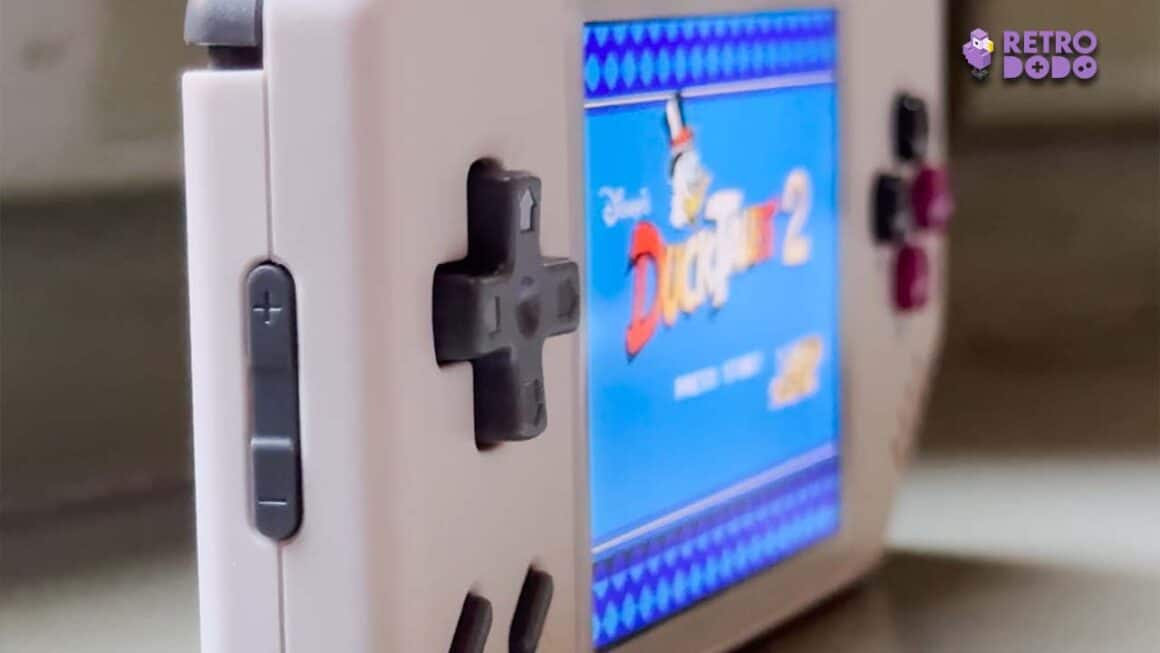
The RG28XX weighs just 0.125 KG (125 grams for folk who like things simple), which is about one-third of the weight of a can of soup according to my favourite measuring comparison website (yeah, I’ve got a favourite!). The main advantage is that you don’t get tired while playing for hours on end, and honestly, it doesn’t feel cheap either. It’s small and light enough to be what I would class as ‘quirky’, a fun handheld that you can stick in your pocket and one that still has enough weight to it to not feel like a cheap piece of junk, which is anything but what the RG28XX is.
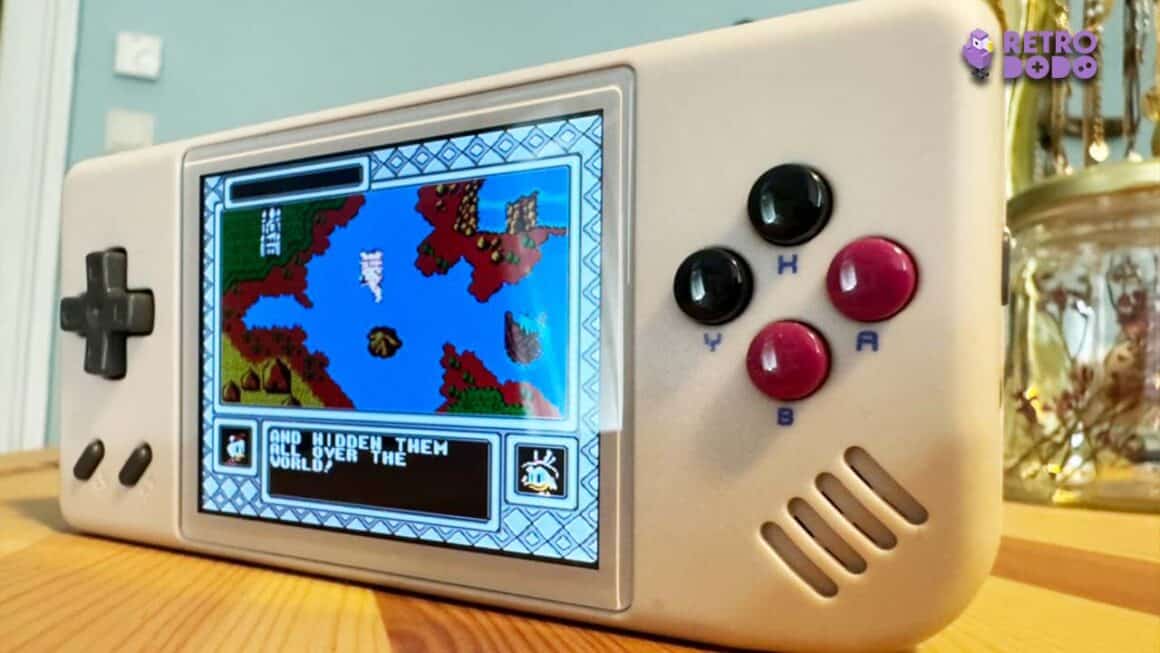
The D-Pad has a nice sturdiness to it; I don’t feel like I’m going to push it through the casing or that it’s wobbling under my fingers. The same can be said for the volume controls, power, reset, and menu buttons – they all feel firm and solid and recessed nicely into the casing.
Can you feel the tone dropping again? It’s because I’m about to talk about the shoulder buttons. The L1/R1 shoulder buttons are recessed nicely into the casing, but they’re so small that they’re basically non-existent. Then the L2 and R2 buttons stick up out of the console and have some slight movement as a result which isn’t great. If you consider the L and R buttons on the Retroid Pocket 2S which are curved and large enough for your finger to actually get a purchase on, then the RG28XX falls way below the bar in comparison.
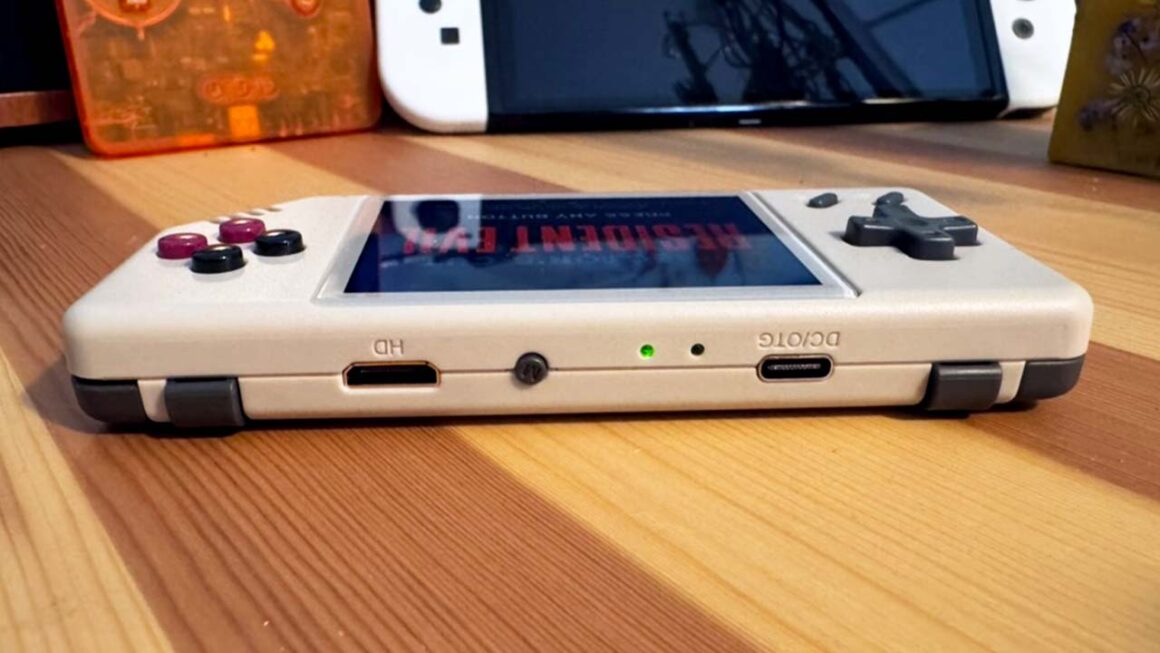
The one thing I will say in favour of those L2/R2 buttons is that the height actually helps me to differentiate between the two sets of shoulder buttons without having to look at where I’m putting my fingers mid-game, and it needs to be that way because they’re so tiny that my finger would easily press both.
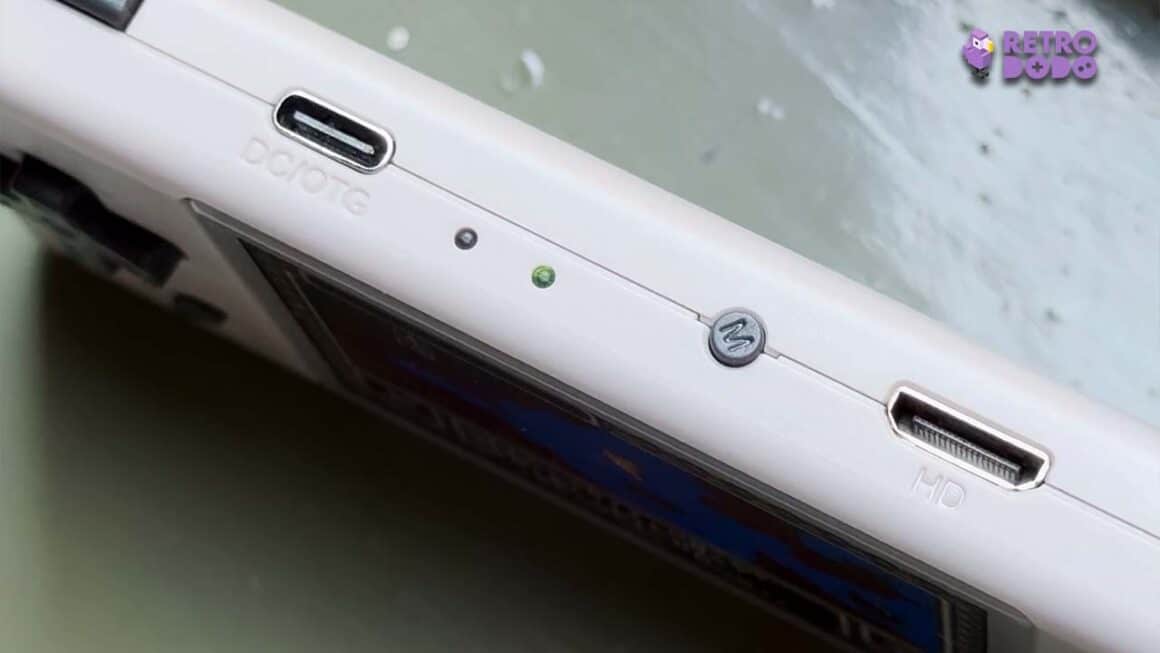
The bottom of the handheld has space for two SD cards. As I’ve already noted, mine came with ROMs already preloaded for me to play on which, while undoubtedly sitting within a grey area, has made my life a heck of a lot easier. On the top of the handheld is a USB-C charging slot for fast charging and a mini HDMI out to play games on your TV. The console itself is compatible with both wired and wireless controllers, so effectively you’ve not just got a retro handheld here, but also a bona fide retro gaming console all in a package that weighs less than your dinner (providing your dinner is, as we’ve already established, a can of soup).
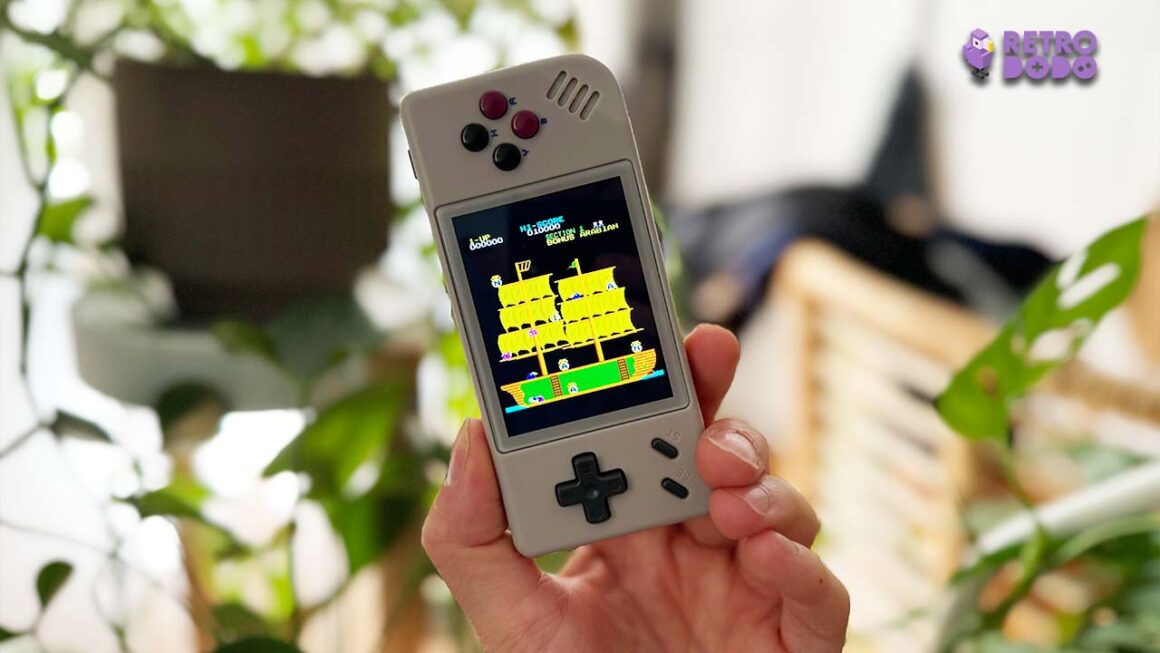
Vertical & Horizontal Play
One little thing that I want to touch on here is the fact that this handheld can cope with both horizontal and vertical play, allowing for some slick little vertical arcade titles using the D-pad and the select & start buttons as your main buttons with shoulder buttons kickstarting the game. It’s a small thing but one that adds extra value for money, especially if many of our readers haven’t had much experience with vertical shooters.
In vertical mode, the screen suddenly feels like the flip phones we used to have as kids – man this handheld keeps taking me back! Games like Battle Lane! Vol 5 and Eight Forces play well and add yet another string to the RG28XX’s bow.
How Much Does It Cost?
The official Anbernic website currently lists the RG28XX at $39.99, which equates to £31.44 and €36.61, so the cost is going to be under the 40 notes mark wherever you’re buying from. Honestly, I think that’s a great price for what this thing can do and it reflects the fact that this isn’t a premium handheld nor likely to be your main gaming handheld. It’s a nice price for those looking to buy a handheld to take out on the go with them or for a present to someone who’s just getting into Retro Gaming.
The consoles come in Lava Orange, Grey (used in this article), Beige White, or Black Transparent, which is the look you might well expect an Anbernic device to look like.
It’s worth noting that it is also available on Amazon as listed at the beginning of this article but at an increased price point. Still, if you prefer the safety of ordering through Amazon as well as the ease of the returns policy, then you can always go down this route.
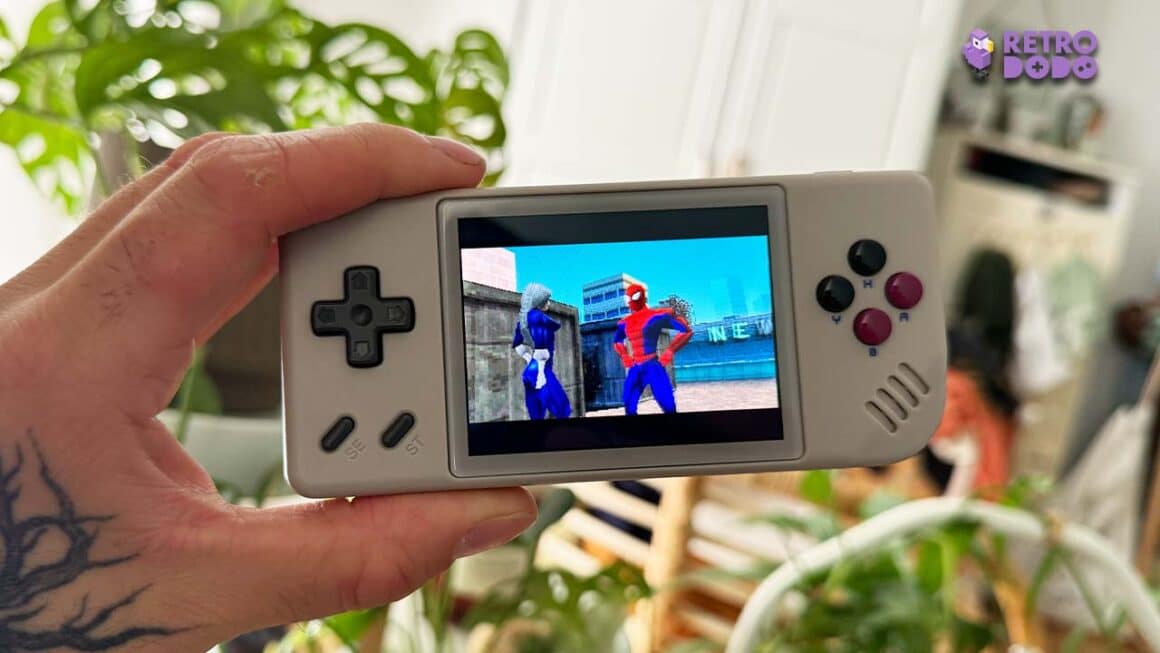
Final Thoughts
- An affordable handheld that emulates most retro consoles
- PS1 games work great
- Brilliant user experience & easy to navigate
- Shoulder buttons are non-existent
- Only a handful of PSP games work
- Too small to be your main handheld
To summarise my time with the Anbernic RG28XX, I would say that it’s a nifty little handheld thwarted only by its size. It’s a portable powerhouse, make no mistake, with the ability to emulate games such as Crazy Taxi, Resident Evil, Pokémon Fire Red, Crash Bandicoot, and much more with ease. While only a handful of PSP games work, I’ve got no qualms when it comes to how this thing performs in terms of emulation and UX, but as I’ve said countless times, I’m not going to be using this thing as my main handheld.
When you go from holding this to grabbing hold of the RG35XXSP, the difference is night and day. The same goes for the Analogue Pocket too; the RG28XX is portable and the kind of thing you’d buy to chuck in your bag and take on a trip for gaming on the bus or plane when you don’t want to be bogged down with a larger handheld weighing your pocket down, as well as taking to a friend’s house to hook up to their TV.
In terms of competitors, I would say that the RG28XX is far better than the older Powkdiddy RGB10S, a handheld that you might remember we said ‘doesn’t excite’. Still, the build quality isn’t as good as the Miyoo Mini which, albeit a vertical handheld and not horizontal, comes in at a similar price point.
Despite some of its flaws, I have spent some enjoyable hours with this console, albeit with the handheld quite close to my face. It’s not the kind of thing you’d play on the sofa with the TV on in the background; this requires your concentration and eyes like a hawk, eyes that would feel a little strained with Netflix going off in the background. Still, for $39.99, you really can’t go wrong with the RG28XX, and it’s a handheld I’ll be keeping close by for when travelling and in gaming emergencies when the big players need to be put on charge.

